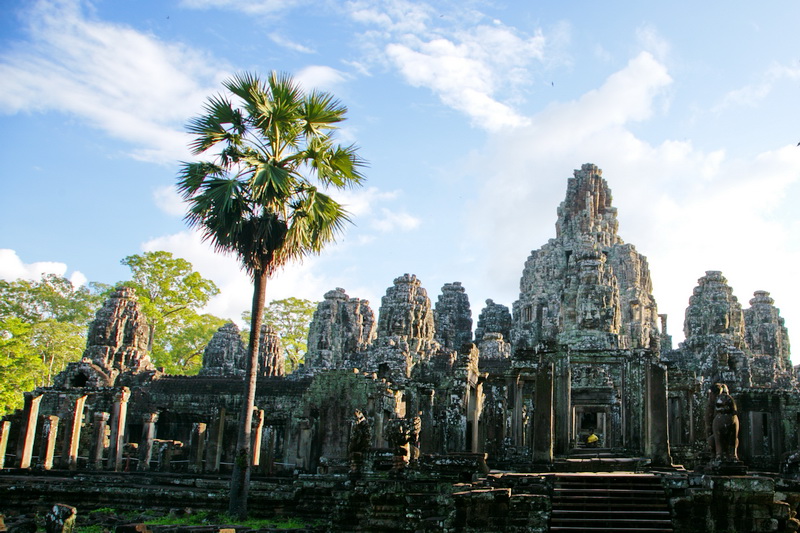About Cambodia
Cambodia is a country with an incredible history that as left many remnants for visitors to behold, as well as a stunning culture to experience. The country is rising quickly on the chart as a top holiday destination for its beauty, historical sites and torrid climate. Angkor Wat, UNESCO World Heritage Site is one of the most famous destination in Cambodia where travelers can witness the magnificent ancient culture of the Khmer empire. Other sites such as Tonle Sap Lake with its stunning scenery and the Mekong Delta are also reasons for visiting the Kingdom of Cambodia.

GENERAL INFORMATION
Kingdom of Cambodia
Population: 15.9 million
Capital City: Phnom Penh (Pop: 1.5 million)
People: Khmers (90%)
Language: Khmer
Currency: Riel and US dollars
Time Zone: GMT +7 Hours
International Dialing Code: +855
History
Cambodia is gaining recognition for its beauty and friendly, welcoming people. However, its tragic history is perhaps its most significant legacy.
Cambodia, due to its welcoming and friendly people and natural beauty, the country is gaining more popularity among travelers, but perhaps the most significant reason for its popularity is the tragic history of the country.
Cambodia’s most magnificent cultural destination is Angkor Wat, that became a top destination for exploration. This towering ancient complex is the largest religious structure on the globe, located at the heart of Cambodia, and depicts the Cambodian cultural pride and heritage. Featured on its flag even today, this ancient structure was once the epicenter of the Khmer Empire, which ruled most of the Indochinese peninsula during the 11th till the 14th century.
Business hours
Offices are usually open from Monday to Friday from 07:30 or 08:00 until 17:00 and often close for lunch between 12:00 and 14:00. Shops open early and close anytime between 18:00 and 22:00. Most shops are open 7 days a week.
Public Holidays
There are many religious public holidays in Cambodia with the main being the Khmer New Year which takes place on 14th to 16th of April every year. The celebrations usually go on for about a week. Another big holiday is Pchum Ben, also known as Ancestor's Day, a national holiday that was established for Buddhists to pay their respects to their deceased relatives and usually celebrated around September or October.
Climate
Cambodia has a tropical climate, but depending on the area you're visiting, the weather can be different.
Rainy from June to October and dry from November to May. Traveling during the rainy season has its benefits as the temple moats in Siem Reap are full, making for great photographic material.
The dry season can be very dusty, but makes walking through the jungle terrain around the temples easier. The temperature is fairly steady, around 30 degrees Celsius during the day time, November to January often has cooler temperatures.
Mid-November to February: Dry and cool
March to May: Dry and hot
June to September: Wet and hot
October to early November: Wet and cool
Travel time
The best time of the year to travel to Cambodia is October through March when there is dry season, temperatures are more moderate and not too hot
Currency
The currency of Cambodia is called the Riel. There is however no need to change your currency into Riel as is common with most Asian countries, US dollars are accepted in many places and are used to pay for airline tickets, airport taxes, visa fees, hotel and restaurant bills.
Post, telephone, and internet access
If you have worldwide coverage, you can bring your own mobile phone and use it to make domestic or international calls. Check with your mobile phone provider for the costs before using it abroad as calling in foreign countries can by pricey. Internet cafes offer good deals for an afternoon of using the internet to catch up to your family and friends.
Internet access is widely available in every major city in Cambodia at the restaurants, hotels and sometimes coffee shops.
Transportation
Taxis are generally only used to and from the airport, and are at a set price. Tuk-tuks are available around towns and cities with an approximate cost of $1-3 per journey in Siem Reap and around $2 - $3 in Phnom Penh. In both cities, short journeys of less than 1 kilometer are usually $1, but prices tend to increase at night.
Tipping
Tipping is not expected, although it will be much appreciated by people who earn an average of US$50 a month working in a restaurant. A few thousand Riel or one US dollar is enough if you are satisfied with their service




